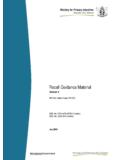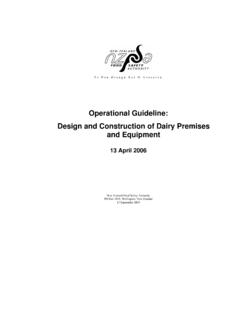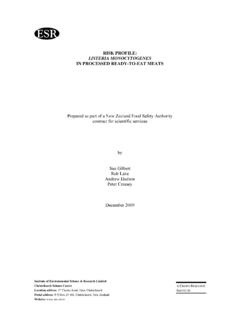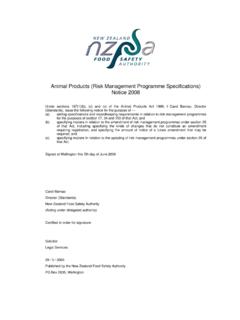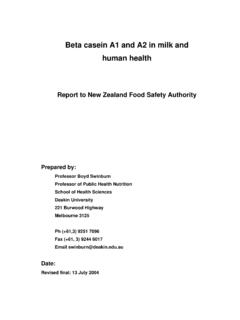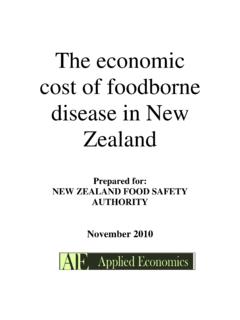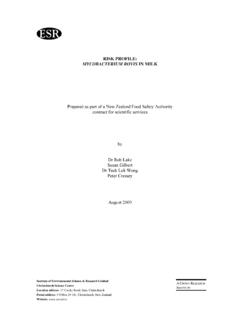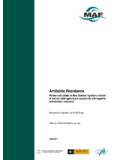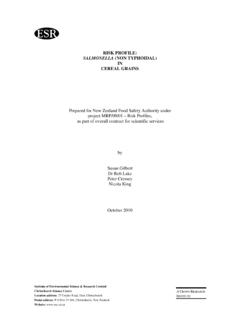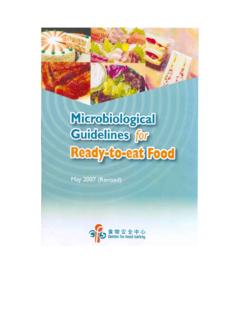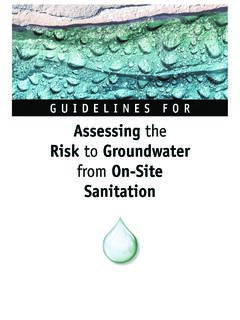Transcription of MICROBIOLOGICAL REFERENCE CRITERIA FOR FOOD
1 _____ food Administration Manual S. 11: MICROBIOLOGICAL CRITERIA Version October 1995 Page 1 MICROBIOLOGICAL REFERENCE CRITERIA FOR food October 1995 Acknowledgments The food Administration section of the Ministry of Health wishes to thank the Institute of Environmental Science and Research Ltd and the many people in industry, the health sector, and other organisations for their considerable help in producing this document. food Safety can only be assured by the use of food safety programmes based on the principles of HACCP. Reliance on MICROBIOLOGICAL CRITERIA /product testing alone is not sufficient. These CRITERIA are formulated as a guide to indicate when food can be considered unacceptable or unsafe. _____ food Administration Manual S. 11: MICROBIOLOGICAL CRITERIA Version October 1995 Page 2 CONTENTS 1 INTRODUCTION.
2 5 2 SAMPLING AND INTERPRETATION .. 7 3 MICROBIOLOGICAL STANDARDS .. 9 Cheese .. 9 Ice cream, frozen confections .. 9 Milk .. 9 Pulped egg .. 10 Yoghurt .. 10 food containers .. 11 4 GENERAL MICROBIOLOGICAL REFERENCE CRITERIA FOR LISTERIA MONOCYTOGENES .. 12 Ready-to-eat food .. 12 All foods produced by a process which is capable of achieving a Listeria-free product .. 12 Summary of actions to be taken by industry on food samples positive for Listeria monocytogenes.
3 14 5 GENERAL MICROBIOLOGICAL REFERENCE CRITERIA FOR FOODS .. 15 Cheese .. 15 Chocolate Products .. 15 Coconut .. 15 Cream .. 15 Cultured Seeds and Grains .. 15 Egg .. 16 Foods - miscellaneous, dried .. 16 Foods - cooked, ready-to-eat .. 16 Foods - requiring further cooking .. 17 Frogs Legs .. 17 Fruit - dried .. 17 Gelatin .. 17 Herbs and Spices .. 18 Ice .. 18 Ice Cream .. 18 Infant (Baby) Foods.
4 18 Margarine and Salted Butter .. 19 Mayonnaise .. 19 food Safety can only be assured by the use of food safety programmes based on the principles of HACCP. Reliance on MICROBIOLOGICAL CRITERIA /product testing alone is not sufficient. These CRITERIA are formulated as a guide to indicate when food can be considered unacceptable or unsafe. _____ food Administration Manual S. 11: MICROBIOLOGICAL CRITERIA Version October 1995 Page 3 Meat and Meat Products .. 19 Milk .. 21 Packaged Waters .. 22 Pasta .. 22 Poultry .. 23 Puddings - powders .. 24 Salads.
5 24 Seafoods .. 24 Soups - dried .. 26 Spices .. 26 Yoghurt .. 26 food Safety can only be assured by the use of food safety programmes based on the principles of HACCP. Reliance on MICROBIOLOGICAL CRITERIA /product testing alone is not sufficient. These CRITERIA are formulated as a guide to indicate when food can be considered unacceptable or unsafe. _____ food Administration Manual S. 11: MICROBIOLOGICAL CRITERIA Version October 1995 Page 4 MICROBIOLOGICAL REFERENCE CRITERIA FOR food These REFERENCE CRITERIA are formulated as a guide for regulators to assess when foods can be considered unacceptable or unsafe. They apply until the end of the given shelf life of a particular food .
6 The Ministry of Health recommends industry strive for more stringent specifications. MICROBIOLOGICAL knowledge is expanding rapidly. Therefore regardless of what is printed here no food provided for public consumption should contain any microorganisms or biotoxin at a level identified as capable of causing foodborne disease. These CRITERIA will be reviewed regularly. Please ensure you have the latest version. 1 INTRODUCTION There are two CRITERIA referred to in this document, standards and REFERENCE CRITERIA . MICROBIOLOGICAL Standards are part of the New Zealand food Regulations 1984 which clearly establishes a MICROBIOLOGICAL content or level that it is unlawful to exceed. They are legislative and mandatory. As such they are identified separately to REFERENCE CRITERIA . MICROBIOLOGICAL REFERENCE CRITERIA are not part of a New Zealand law.
7 They are to be used where no standard exists in law to monitor the MICROBIOLOGICAL safety of a manufacturing process or the safety of a food . They may be used as supplements to existing standards where public health concerns dictate. The MICROBIOLOGICAL REFERENCE CRITERIA can be of prime importance in deciding if a food is unsound or in reinforcing other observations and providing reasons to suspect that a food may not meet sound public health practices. If the bacteriological quality is outside these REFERENCE CRITERIA , an audit of the company's food safety programme will almost inevitably reveal unsatisfactory practices. NB. Foods made with components which have their own CRITERIA (eg cheese, cooked meat), but which are used in combination with other foods (eg prepared meals, sandwiches), should be assessed against CRITERIA or food Safety can only be assured by the use of food safety programmes based on the principles of HACCP.
8 Reliance on MICROBIOLOGICAL CRITERIA /product testing alone is not sufficient. These CRITERIA are formulated as a guide to indicate when food can be considered unacceptable or unsafe. _____ food Administration Manual S. 11: MICROBIOLOGICAL CRITERIA Version October 1995 Page 5 These standards and REFERENCE CRITERIA have been developed taking into consideration the following: New Zealand food Regulations 1984 Publications of the Codex Alimentarius Commission of the food and Agriculture Organisation of the United Nations World Health Organisation Publications of the United States Health and Welfare food and Drug Agency Publications of the International Commission of Microbial Specifications for food Publications of the Australian National Health and Medical Research Council Publications of the Australian National food Authority Principles and Practice for the "Safe Processing of Foods" ed.
9 David A and Norah F Shapton, Butterworth Heinemann 1991 British food Manufacturing Industries Research Association, food Legislation Survey, MICROBIOLOGICAL Standards for Foodstuffs - 2nd ed. The preferred methods of analysis are those described in the Compendium of Methods for the MICROBIOLOGICAL Examination of Foods, APHA, 1992. - American Public Health Association (APHA). Note: It is the Ministry of Health's intention that " REFERENCE CRITERIA " will progressively replace existing MICROBIOLOGICAL "Standards" in the regulations. There will instead be REFERENCE in the regulations to appropriate CRITERIA to assist with regulatory requirements for safe food . food Safety can only be assured by the use of food safety programmes based on the principles of HACCP. Reliance on MICROBIOLOGICAL CRITERIA /product testing alone is not sufficient.
10 These CRITERIA are formulated as a guide to indicate when food can be considered unacceptable or unsafe. _____ food Administration Manual S. 11: MICROBIOLOGICAL CRITERIA Version October 1995 Page 6 2 SAMPLING AND INTERPRETATION The REFERENCE CRITERIA are expressed in the format prepared by the International Commission on MICROBIOLOGICAL Specifications for Foods (ICMSF). The ICMSF Scheme assists with the practical difficulties of representative sampling and interpretation of data provided by the laboratory. It permits some degree of tolerance to compensate for the difficulties of statistical sampling, and non-uniformity of bacterial load. The following terms as used by the ICMSF are used in these REFERENCE CRITERIA . n = The number of sample units which must be examined from a lot of food to satisfy the requirements of a particular sampling plan.
